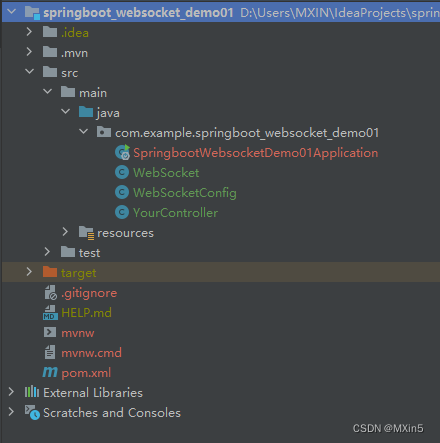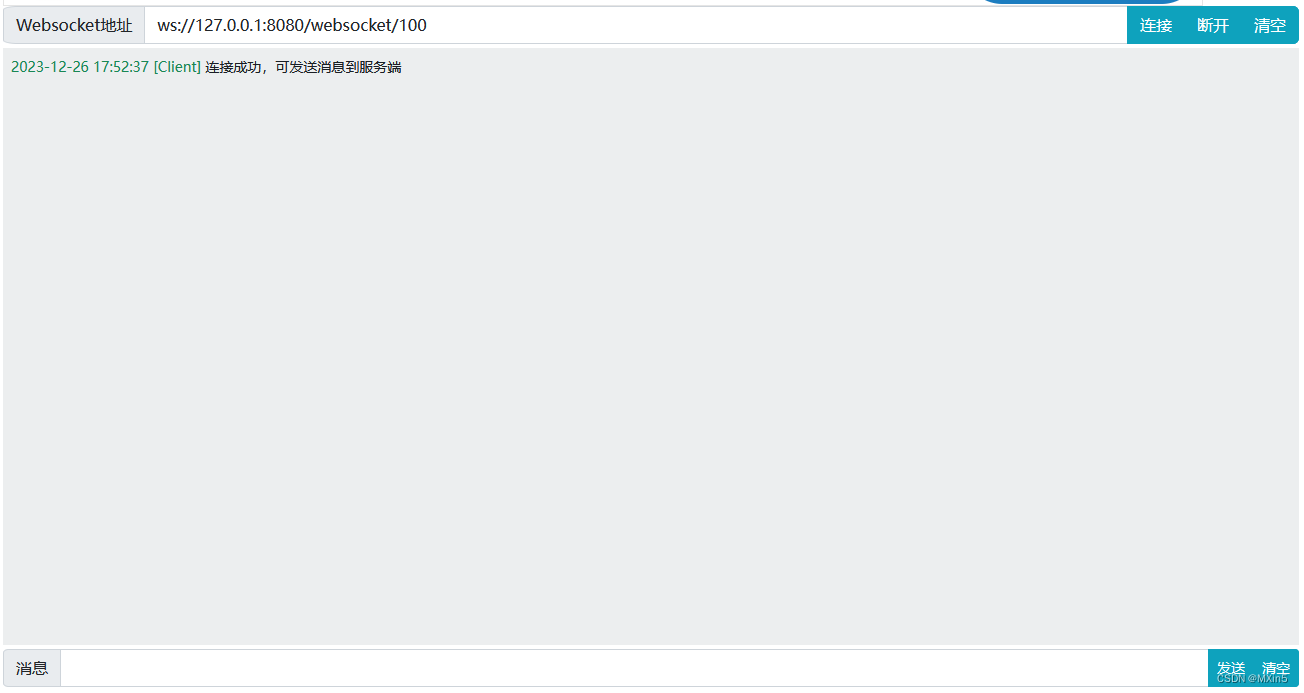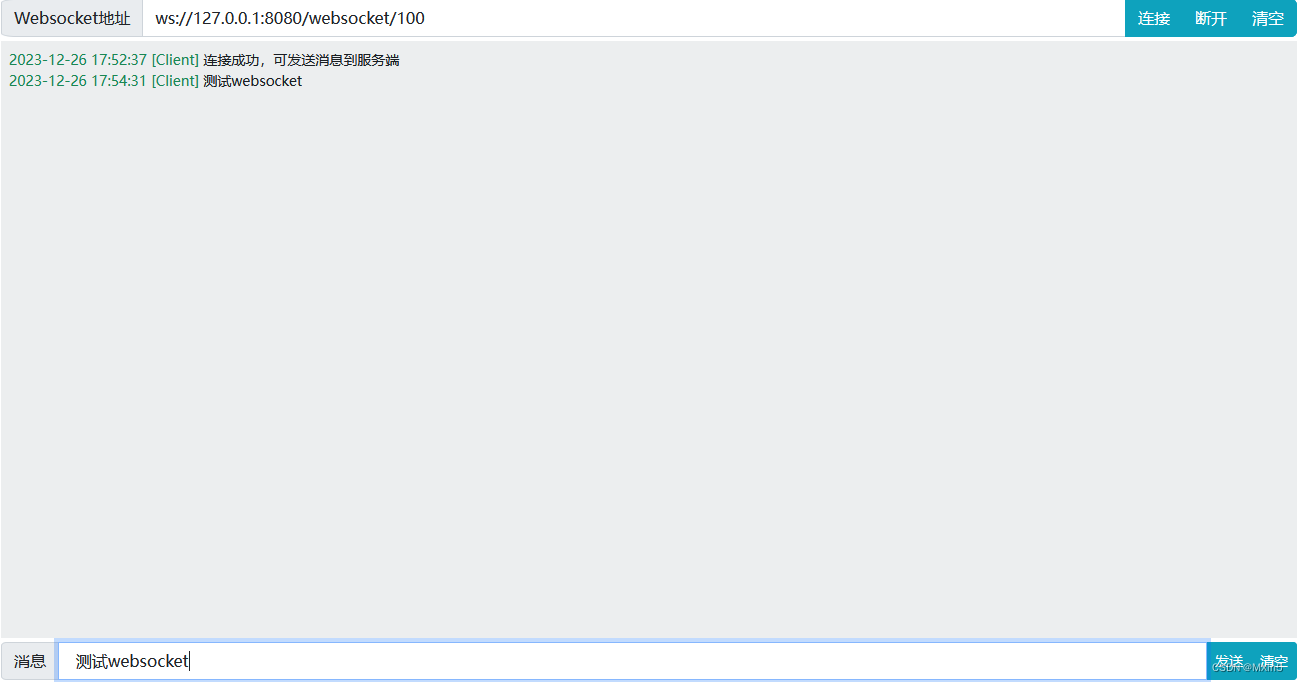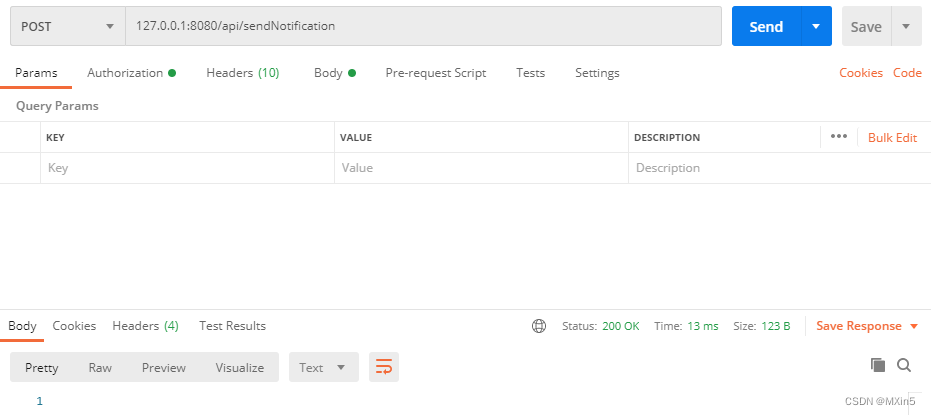目录
什么是websocket?
websocket是一种在单个tcp连接上进行全双工通信的协议。websocket使得客户端和服务器之间的数据交换变得更加简单,允许服务端主动向客户端推送数据。而http请求只能从客户端请求服务端才能得到响应。在websocket api中,浏览器和服务器只需要完成一次握手,两者之间就直接可以创建持久性的连接,并进行双向数据传输。
websocket可以用来做什么?
利用双向数据传输的特点可以用来完成很多功能,不需要前端轮询,浪费资源。例如:
聊天功能、数据实时更新和视频弹幕等
websocket协议
本协议有两部分:握手和数据传输。
握手是基于http协议的。
来自客户端的握手看起来像如下形式:
来自服务器的握手看起来像如下形式
springboot快速整合websocket代码案例:
下面我就使用springboot快速整合websocket实现服务端与客户端的相互推送消息;
代码层级结构

maven依赖
<!--websocket的依赖-->
<dependency>
<groupid>org.springframework.boot</groupid>
<artifactid>spring-boot-starter-websocket</artifactid>
</dependency>websocket配置类
package com.example.springboot_websocket_demo01;
import org.springframework.context.annotation.bean;
import org.springframework.context.annotation.configuration;
import org.springframework.web.socket.server.standard.serverendpointexporter;
@configuration
public class websocketconfig {
/**
* 注入serverendpointexporter,
* 这个bean会自动注册使用了@serverendpoint注解声明的websocket endpoint
*/
@bean
public serverendpointexporter serverendpointexporter() {
return new serverendpointexporter();
}
}websocket操作类
通过该类websocket可以进行群推送以及单点推送
package com.example.springboot_websocket_demo01;
import jakarta.websocket.*;
import jakarta.websocket.server.pathparam;
import jakarta.websocket.server.serverendpoint;
import lombok.extern.slf4j.slf4j;
import org.springframework.stereotype.component;
import java.util.concurrent.concurrenthashmap;
import java.util.concurrent.copyonwritearrayset;
@component
@slf4j
@serverendpoint("/websocket/{userid}") // 接口路径 ws://localhost:8087/websocket/userid;
public class websocket {
//与某个客户端的连接会话,需要通过它来给客户端发送数据
private session session;
/**
* 用户id
*/
private string userid;
//concurrent包的线程安全set,用来存放每个客户端对应的mywebsocket对象。
//虽然@component默认是单例模式的,但springboot还是会为每个websocket连接初始化一个bean,所以可以用一个静态set保存起来。
// 注:底下websocket是当前类名
private static copyonwritearrayset<websocket> websockets = new copyonwritearrayset<>();
// 用来存在线连接用户信息
private static concurrenthashmap<string, session> sessionpool = new concurrenthashmap<string, session>();
/**
* 链接成功调用的方法
*/
@onopen
public void onopen(session session, @pathparam(value = "userid") string userid) {
try {
this.session = session;
this.userid = userid;
websockets.add(this);
sessionpool.put(userid, session);
log.info("【websocket消息】有新的连接,总数为:" + websockets.size());
} catch (exception e) {
}
}
/**
* 链接关闭调用的方法
*/
@onclose
public void onclose() {
try {
websockets.remove(this);
sessionpool.remove(this.userid);
log.info("【websocket消息】连接断开,总数为:" + websockets.size());
} catch (exception e) {
}
}
/**
* 收到客户端消息后调用的方法
*
* @param message
*/
@onmessage
public void onmessage(string message) {
log.info("【websocket消息】收到客户端消息:" + message);
}
/**
* 发送错误时的处理
*
* @param session
* @param error
*/
@onerror
public void onerror(session session, throwable error) {
log.error("用户错误,原因:" + error.getmessage());
error.printstacktrace();
}
// 此为广播消息
public void sendallmessage(string message) {
log.info("【websocket消息】广播消息:" + message);
for (websocket websocket : websockets) {
try {
if (websocket.session.isopen()) {
websocket.session.getasyncremote().sendtext(message);
}
} catch (exception e) {
e.printstacktrace();
}
}
}
// 此为单点消息
public void sendonemessage(string userid, string message) {
session session = sessionpool.get(userid);
if (session != null && session.isopen()) {
try {
log.info("【websocket消息】 单点消息:" + message);
session.getasyncremote().sendtext(message);
} catch (exception e) {
e.printstacktrace();
}
}
}
// 此为单点消息(多人)
public void sendmoremessage(string[] userids, string message) {
for (string userid : userids) {
session session = sessionpool.get(userid);
if (session != null && session.isopen()) {
try {
log.info("【websocket消息】 单点消息:" + message);
session.getasyncremote().sendtext(message);
} catch (exception e) {
e.printstacktrace();
}
}
}
}
}注意:websocketconfig和websocket必须放在同一层级下,否则websocket扫描不到serverendpoint注解。
一:测试客户端向服务端推送消息
1.启动springboot项目

2.打开网站
输入
ws://127.0.0.1:8080/websocket/100进行连接,测试是否连接成功

3.进行测试消息推送

4.后端进行查看测试结果
![]()
测试成功,说明客户端可以使用websocket对服务端推送消息。
二:测试服务端向客户端推送消息
1.接口代码
package com.example.springboot_websocket_demo01;
import org.springframework.beans.factory.annotation.autowired;
import org.springframework.web.bind.annotation.postmapping;
import org.springframework.web.bind.annotation.requestmapping;
import org.springframework.web.bind.annotation.restcontroller;
@restcontroller
@requestmapping("/api")
public class yourcontroller {
@autowired
private websocket websocket;
@postmapping("/sendnotification")
public void sendnotification() {
try {
// 创建业务消息信息
string message = "postman调用接口访问后端服务器存储数据并使用websocket将消息推送给前端客户端";
// 全体发送
websocket.sendallmessage(message);
// 单个用户发送 (userid为用户id)
string userid = "1";
string message1 = "【websocket消息】 单点消息:只发送给id为"+userid+"的用户。";
websocket.sendonemessage(userid, message1);
// 多个用户发送 (userids为多个用户id,逗号‘,’分隔)
string[] userids = {"1", "2"};
string message2 = "【websocket消息】 单点消息:只发送给id为"+userids.tostring()+"的用户。";
websocket.sendmoremessage(userids, message2);
} catch (exception e) {
// 输出异常信息
e.printstacktrace();
}
}
}
2.使用postman进行调用
用来模仿客户端发送消息到后端服务器然后返回给客户端。(其实也可以直接在websocket类中的onmessage中直接进行操作,调用sendallmessage等其他方法进行测试);

3.查看测试结果
正常结果为



还有很多测试方法,自己可以去思考,以上对于springboot整合websocket来说可以算是一个简单的入门案例了。





发表评论